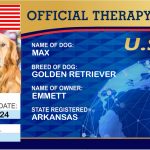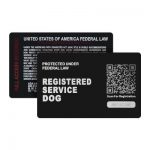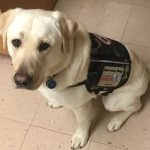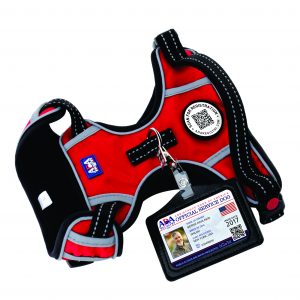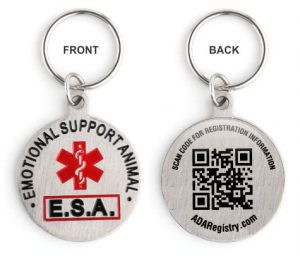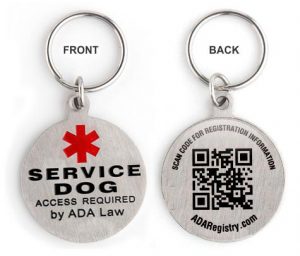Hearing Guide Dog
June 22, 2020
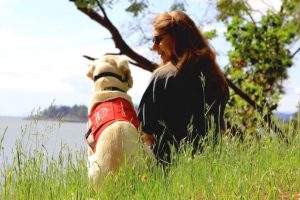
Shay’s suit has two components: a red vest with “Lion’s Foundation of Canada Dog Guides [LFCDG] Hearing Dog Guide” written on it and a head harness called a Halti. The Halti looks a bit like a muzzle but doesn’t prevent Shay from opening her mouth as widely as she wants. With the leash connected to the Halti and the collar, I can feel where Shay is turning her head even when I’m not looking at her. Thus, I am aware of her reacting to sounds beside and behind me—even when I cannot hear them—and this gives me a sense of security that I have not known since my first hearing loss when I was four years old.
Gaining more confidence in moving through the world is an aspect of having a Dog Guide that I never anticipated. Having coped with my disability since I was small, I thought I was fine. I did not realize how very constantly I was on the alert, always trying to use my other senses to compensate for the enormous gap where hearing ought to be. When I was a child, I saw a poster at the Western Institute for the Deaf and Hard of Hearing that showed the words “Silence is golden.” “Golden” was crossed out and replaced with “lonely” and “isolating.” Even then, the truth of this correction struck me viscerally.
Since I learned to speak before my hearing loss (no hearing in my left ear, moderate to severe loss in my right ear), my voice does not reflect that loss. People therefore tend to assume the loss is minor and treat me accordingly, even when I tell them that I’m hearing impaired. Naturally, this leads to misunderstandings. Much more emotionally challenging for me, though, is the everyday experience of feeling excluded and isolated. For 55-odd years, I’ve relied on lip-reading and guesswork and this extra layer of effort is literally exhausting.
With Shay dressed for work and by my side, people actually believe me when I say that I can’t hear. When I tell them that I need to read their lips, they remember more often to look at me when they speak, and they’re more accommodating when I ask them to repeat something for the third or fourth time. They’re also less likely to think me stupid or rude for not understanding them the first time. For me, the difference is astounding and somehow liberating. And it’s all because of Shay.
The bulk of Shay’s work, though, happens at home where she remains on duty even though she’s not in her suit. She alerts me to sounds like the doorbell, door knocking, timers, my morning alarm, my phone, the fire alarm, and someone calling my name. For all but the fire alarm, she gets my attention by placing her paw on me, then leading me to the sound’s source. For the fire alarm, since I wouldn’t want her to lead me into a fire , she instead spins around three times. Now I’m more comfortable in my own home, another thing that I hadn’t realized was possible. Sometimes we play a game where I or someone in my family hides the timer in an unexpected place and Shay has a wonderful time searching it out. She’s so proud of herself when she finds it! And of course she gets big treats. As our wonderful instructors at Dog Guides Canada said, “We work for money; they work for treats,” which really isn’t so different when you think about it.
Shay does love her treats and is very clear about her favourite ones. The ball—a particular ball that’s chewable but bounces well—is up near the top. And grooming is a frequent highlight, since she must be as clean and presentable as possible when we’re out in public.
We share work and playtime and walks and Shay loves her Shaymobile, the bike trailer in which she rides. Only when Shay is in her crate a couple of times a week does she have complete time off. In this way, Shay’s life is a bit different from some of the other Dog Guides trained at LFCDG, like the vision ones whose primary work is outside the home.
In addition to Hearing Dog Guides, LFCDG trains Vision, Seizure Response, Service, Autism Assistance, Diabetic Alert and Facility Support Dog Guides. Their policy is no force-based training, and this gentle, loving, consistent approach is reflected in all the people who give their time and love to breeding, fostering and training the dogs, who grow into happy, enthusiastic canine citizens whether they graduate from Dog Guide training or become family dogs instead. LFCDG relies on corporate and private donations to fulfill its mission of assisting Canadians with a medical or physical disability by providing them Dog Guides at no cost. Since the actual cost of training a Dog Guide is $25,000, this is quite a feat. This year, LFCDG’s main annual fundraiser raised one-sixth of what it normally raises, so the deadline has been extended and the goal revised dramatically downward. If you’re able and interested, please do donate to support this work which makes such a very great difference in the lives of so many people. Shay and I are registered as a participant, so you can donate via us if you wish.
Since Shay and I go everywhere together, our lives are now so intertwined that we know each other’s rhythms intimately. It’s an interesting partnership in which Shay knows that, when it comes to sound, she takes the lead and I follow. Her confidence in her hearing and my trust in her build upon each other. Yet, close as we are, Shay is not my dog. Remember that $25,000 cost to train a Dog Guide? LFCDG retains ownership of its dogs so that they can re-home a dog should they judge that its skills are not being used or it is being ill-treated. Oddly, for me, this fact is a reminder of how very lucky I am to love and work with this tremendously talented canine companion whose skills and devotion expand my world.
Check Out Our Store


